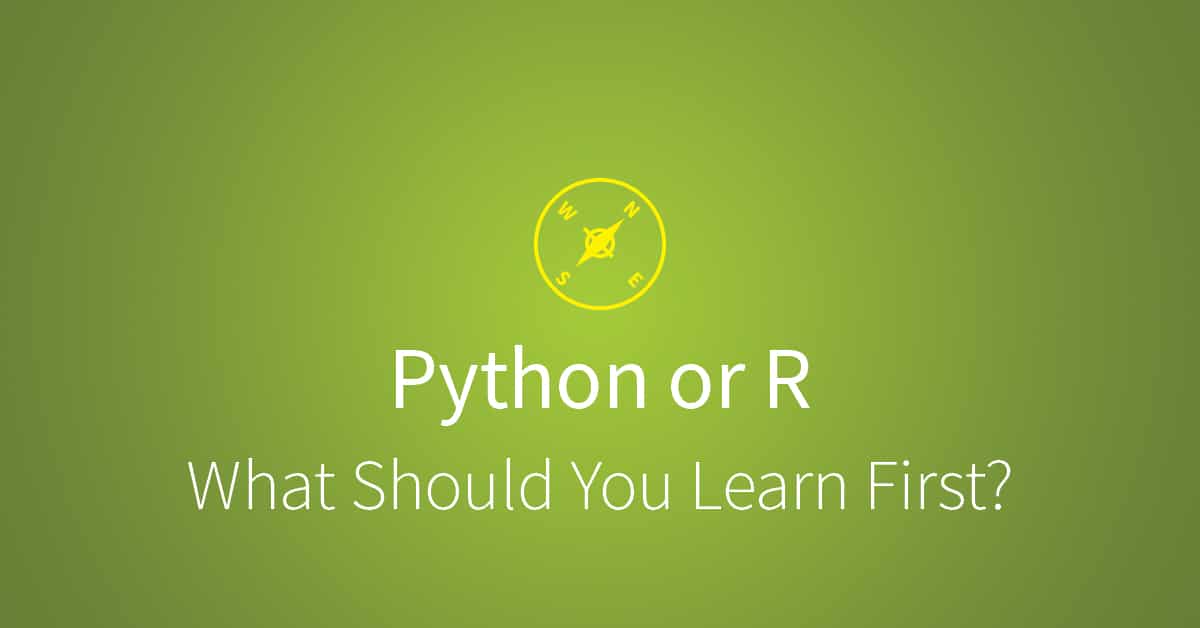Updated: July 19, 2021

If you’re an aspiring data specialist, you may have heard that Python and R are the two most popular languages for data analysis. But at the beginning, choosing whether to learn Python or R first might be daunting.
To help you along, we’ve prepared this guide to break down both Python and R. Keep reading as we cover their comparative strengths and weaknesses, before reaching our verdict.
Spoiler: you cannot go wrong with either language!
The Case for R
R has boasts widespread adoption within the data science community. Thanks to R’s popularity, you can always get support if you need assistance with using the language. What’s more: there are thousands of publicly released packages that you can use with R to extend its capabilities to new heights. This allows R to provide a solution to virtually any data-related problem. Whether you need to perform statistical analysis, create a graph, or build a machine learning model, there’s an R package for the task.
Because R was made primarily for data analysis, common mathematical operations like matrix multiplication work straight out of the box. Moreover, R’s array-oriented syntax facilitates the translation of math into code, which is especially useful for programming novices.
The Case for Python
Python is a “batteries included” programming language, meaning it can do virtually anything you need it to: data engineering, data wrangling, machine learning, website scraping, web development — you name it.
Being an object-oriented programming language, Python facilitates writing large-scale, maintainable, and robust code. With Python, the prototype code that you write on your own computer can be used as production code if needed. Additionally, thanks to its intuitive syntax that resembles English, Python is easier to master than R, especially if you have a background in another object-oriented programming language like Java or C++.
Python previously could not match R in terms of the latter’s packages and libraries available to data professionals. Nowadays, thanks to libraries like Pandas, Numpy, Scipy, Scikit-Learn, and Seaborn, Python is now holding its own in what used to be R’s exclusive domain. What’s more, Python has solidified its position as the preferred language for artificial intelligence with today’s main machine learning projects, Tensorflow and PyTorch, being written in Python.
Choosing Between Python and R
Here are a few guidelines for data specialists who are deciding whether to first learn Python or R.
Personal Preference
The choice between Python and R may be based on your personal preference, or whichever is easier to grasp from the get-go. To be clear, mathematicians and statisticians tend to prefer R, whereas computer scientists and software engineers usually favor Python.
However, mastering programming mostly boils down to acquiring a particular problem-solving mindset. The ability to translate real-life problems into steps that a computer can execute are applicable across all programming languages. Therefore, once you start thinking like a programmer in either Python or R, it’ll be easy to pick up the other—you’ll just have to learn the syntax.
For these reasons, there’s nothing wrong with choosing your first language based purely on personal preference. That way, you’ll be able to create useful programs sooner than would otherwise be the case, allowing you to gain momentum early in the learning process.
Tasks
You can also make the Python vs. R call based on a data project you know you’ll be working on.
If you’re working with data that’s been gathered and cleaned for you, and your main focus is on the number crunching, data visualization, and one-off statistical analyses, go with R. When it comes to advanced statistical techniques, R’s ecosystem is far superior to Python’s.
If you have to work with dirty or jumbled data, or to scrape data from websites, files, or other data sources, Python is a better choice. Additionally, the capabilities of Python’s machine learning ecosystem far exceed that of R’s, especially when it comes to deep learning.
Collaboration
With the basics of data analysis under your belt, another criterion to consider is the language your teammates are using. If you’re all using the same language, it’ll make collaboration—as well as learning from one other—much easier.
That said, Python is hands-down the winner for writing production code, a process which is highly dependent upon collaboration. This is where Python truly outshines R, simply because it better integrates with databases, automation tools, and cloud services.
Popularity
Python is the world’s most popular programming language according to the PYPL language popularity index, which goes by the number of Google tutorial searches to quantify a language’s popularity. According to the list, Python accounts for a whooping 30 percent of all searches—almost 8 times as much as R.
Source: PYPL
These results are hardly surprising given Python’s ubiquity in practically every area of computer science. Python has also become the lingua franca of AI thanks to its deep learning libraries like TensorFlow and PyTorch, which power most cutting-edge AI tools. This has led to Python becoming the dominant language in the industry, whereas R is often the preferred choice among researchers and in academia.
Python vs. R: The Bottom Line
If you’re an aspiring data scientist, you cannot go wrong with either Python or R as your first language. Whereas R emphasizes statistical analysis and number crunching, Python is extremely versatile.
Because both have their pros and cons, your choice should depend on factors like your personal preference, intended use, and/or your team’s language of choice. Keep in mind that learning one language will not preclude you from learning the other. In fact, programming skills are highly transferable across different languages.
Ready to start learning either one of these languages for data science?
At Udacity, we offer expert-designed nanodegree programs to teach you the skills required to kickstart your career in data science. Get started with either Python or R today:
Start learning Python for data science!
Start learning R for data science!





